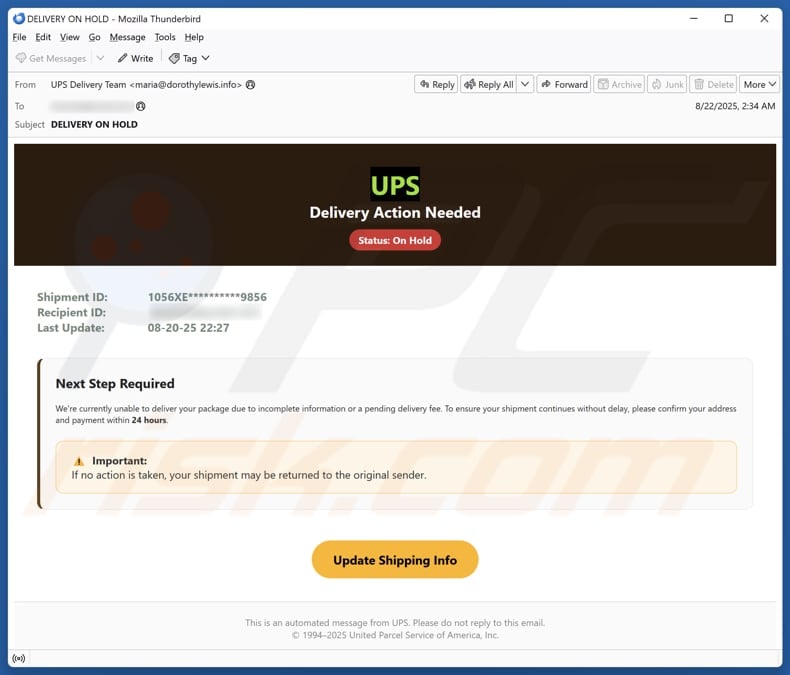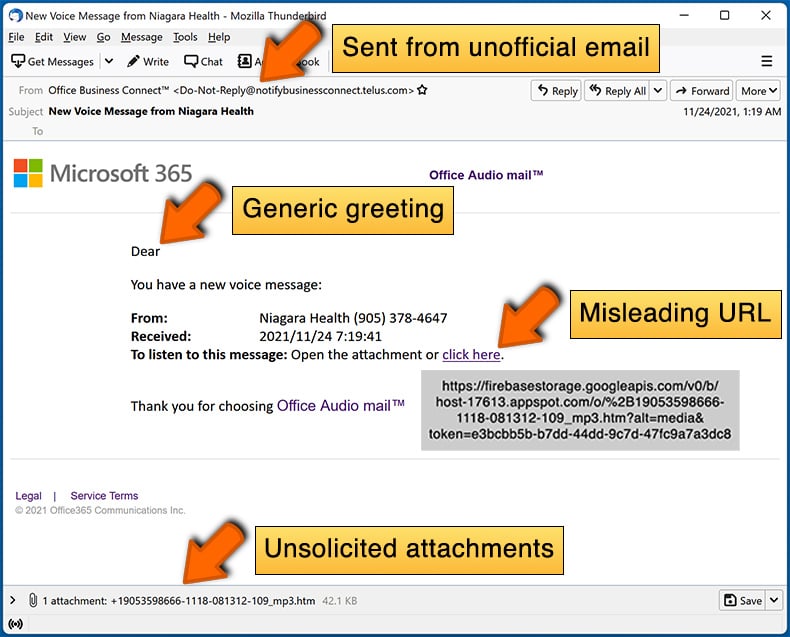How to identify scams like "UPS - Delivery Action Needed"
Phishing/ScamAlso Known As: UPS - Delivery Action Needed phishing scam
Get free scan and check if your device is infected.
Remove it nowTo use full-featured product, you have to purchase a license for Combo Cleaner. Seven days free trial available. Combo Cleaner is owned and operated by RCS LT, the parent company of PCRisk.com.
What is the fake "UPS - Delivery Action Needed" email?
Our team has examined the email and concluded that it is a scam. The message is disguised as a notification from UPS (a legitimate global shipping and logistics company). It is crafted to deceive recipients into sending money and (or) information to scammers. Recipients of this email should ignore it.

More about the "UPS - Delivery Action Needed" scam email
This scam email (with the subject line "DELIVERY ON HOLD") claims to come from UPS. It informs the recipient that their shipment is on hold due to incomplete information or an unpaid delivery fee. To resolve the issue, the email urges the recipient to confirm their address and make a payment within 24 hours.
The email includes fabricated details, such as a shipment ID, recipient ID, and time and date of the last update, to appear legitimate. It also warns that the package may be returned to the sender if no action is taken and provides the "Update Shipping Info" link.
At the time of our inspection, the site included in this email was down. However, it is likely that it was supposed to open a deceptive site (like a fake UPS page). Usually, scammers behind schemes like this one seek to steal money by tricking recipients into paying for fake services (e.g., "shipment" or "administration" fees).
Additionally, they can try to extract personal information, such as credit card details, login credentials, personal identification information, or both information and money. It is important to examine emails before interacting with them to avoid monetary loss, account hijacking, identity theft, or other issues.
| Name | UPS - Delivery Action Needed Email Scam |
| Threat Type | Phishing, Scam, Social Engineering, Fraud |
| Fake Claim | The shipment is on hold |
| Disguise | Notification from UPS |
| Symptoms | Unauthorized online purchases, changed online account passwords, identity theft, illegal access of the computer. |
| Distribution methods | Deceptive emails, rogue online pop-up ads, search engine poisoning techniques, misspelled domains. |
| Damage | Loss of sensitive private information, monetary loss, identity theft. |
| Malware Removal (Windows) |
To eliminate possible malware infections, scan your computer with legitimate antivirus software. Our security researchers recommend using Combo Cleaner. Download Combo CleanerTo use full-featured product, you have to purchase a license for Combo Cleaner. 7 days free trial available. Combo Cleaner is owned and operated by RCS LT, the parent company of PCRisk.com. |
Similar scam emails in general
Scams like this typically impersonate well-known companies to trick recipients into believing there is an urgent/important issue. They include links leading to phishing pages designed to steal personal information and (or) money. Sometimes, such emails can be used to distribute malware.
These emails should be ignored and deleted without clicking any links or providing any data. Examples of similar scams are "Security Notice - AI Assist Now Available", "Welcome To AI Powered Webmail", and "Important Account Update".
How do spam campaigns infect computers?
Cybercriminals spread malware through email by including malicious attachments. These may come in the form of Word or Excel documents, PDFs, scripts, executable files (such as .exe), archives like ZIP and RAR, etc. Opening these files or enabling features like macros (or taking other steps) can lead to the infection of the system.
Malware can also be distributed via malicious links. By clicking such links, users may be redirected to websites that automatically download harmful software or trick them into manually downloading and running it.
How to avoid installation of malware?
Do not open unexpected files or click suspicious links in irrelevant emails (or other messages) from unknown addresses. Regularly update your operating system, browsers, and other applications. Use reliable security software. Do not download software or files from torrent sites or other untrustworthy sources.
Use official pages or app stores when downloading apps or files. Avoid interacting with ads and links (or other elements) on shady websites, and do not permit such sites to send you notifications. If you have already opened malicious attachments, we recommend running a scan with Combo Cleaner Antivirus for Windows to automatically eliminate infiltrated malware.
Text presented in the "UPS - Delivery Action Needed" email letter:
Subject: DELIVERY ON HOLD
UPS
Delivery Action Needed
Status: On Hold
Shipment ID: 1056XE**********9856
Recipient ID: ********
Last Update: 08-20-25 22:27
Next Step RequiredWe're currently unable to deliver your package due to incomplete information or a pending delivery fee. To ensure your shipment continues without delay, please confirm your address and payment within 24 hours.
Important:
If no action is taken, your shipment may be returned to the original sender.
Update Shipping Info
This is an automated message from UPS. Please do not reply to this email.
© 1994–2025 United Parcel Service of America, Inc.
Instant automatic malware removal:
Manual threat removal might be a lengthy and complicated process that requires advanced IT skills. Combo Cleaner is a professional automatic malware removal tool that is recommended to get rid of malware. Download it by clicking the button below:
DOWNLOAD Combo CleanerBy downloading any software listed on this website you agree to our Privacy Policy and Terms of Use. To use full-featured product, you have to purchase a license for Combo Cleaner. 7 days free trial available. Combo Cleaner is owned and operated by RCS LT, the parent company of PCRisk.com.
Quick menu:
- What is UPS - Delivery Action Needed phishing scam?
- Types of malicious emails.
- How to spot a malicious email?
- What to do if you fell for an email scam?
Types of malicious emails:
![]() Phishing Emails
Phishing Emails
Most commonly, cybercriminals use deceptive emails to trick Internet users into giving away their sensitive private information, for example, login information for various online services, email accounts, or online banking information.
Such attacks are called phishing. In a phishing attack, cybercriminals usually send an email message with some popular service logo (for example, Microsoft, DHL, Amazon, Netflix), create urgency (wrong shipping address, expired password, etc.), and place a link which they hope their potential victims will click on.
After clicking the link presented in such email message, victims are redirected to a fake website that looks identical or extremely similar to the original one. Victims are then asked to enter their password, credit card details, or some other information that gets stolen by cybercriminals.
![]() Emails with Malicious Attachments
Emails with Malicious Attachments
Another popular attack vector is email spam with malicious attachments that infect users' computers with malware. Malicious attachments usually carry trojans that are capable of stealing passwords, banking information, and other sensitive information.
In such attacks, cybercriminals' main goal is to trick their potential victims into opening an infected email attachment. To achieve this goal, email messages usually talk about recently received invoices, faxes, or voice messages.
If a potential victim falls for the lure and opens the attachment, their computers get infected, and cybercriminals can collect a lot of sensitive information.
While it's a more complicated method to steal personal information (spam filters and antivirus programs usually detect such attempts), if successful, cybercriminals can get a much wider array of data and can collect information for a long period of time.
![]() Sextortion Emails
Sextortion Emails
This is a type of phishing. In this case, users receive an email claiming that a cybercriminal could access the webcam of the potential victim and has a video recording of one's masturbation.
To get rid of the video, victims are asked to pay a ransom (usually using Bitcoin or another cryptocurrency). Nevertheless, all of these claims are false - users who receive such emails should ignore and delete them.
How to spot a malicious email?
While cyber criminals try to make their lure emails look trustworthy, here are some things that you should look for when trying to spot a phishing email:
- Check the sender's ("from") email address: Hover your mouse over the "from" address and check if it's legitimate. For example, if you received an email from Microsoft, be sure to check if the email address is @microsoft.com and not something suspicious like @m1crosoft.com, @microsfot.com, @account-security-noreply.com, etc.
- Check for generic greetings: If the greeting in the email is "Dear user", "Dear @youremail.com", "Dear valued customer", this should raise suspiciousness. Most commonly, companies call you by your name. Lack of this information could signal a phishing attempt.
- Check the links in the email: Hover your mouse over the link presented in the email, if the link that appears seems suspicious, don't click it. For example, if you received an email from Microsoft and the link in the email shows that it will go to firebasestorage.googleapis.com/v0... you shouldn't trust it. It's best not to click any links in the emails but to visit the company website that sent you the email in the first place.
- Don't blindly trust email attachments: Most commonly, legitimate companies will ask you to log in to their website and to view any documents there; if you received an email with an attachment, it's a good idea to scan it with an antivirus application. Infected email attachments are a common attack vector used by cybercriminals.
To minimise the risk of opening phishing and malicious emails we recommend using Combo Cleaner Antivirus for Windows.
Example of a spam email:

What to do if you fell for an email scam?
- If you clicked on a link in a phishing email and entered your password - be sure to change your password as soon as possible. Usually, cybercriminals collect stolen credentials and then sell them to other groups that use them for malicious purposes. If you change your password in a timely manner, there's a chance that criminals won't have enough time to do any damage.
- If you entered your credit card information - contact your bank as soon as possible and explain the situation. There's a good chance that you will need to cancel your compromised credit card and get a new one.
- If you see any signs of identity theft - you should immediately contact the Federal Trade Commission. This institution will collect information about your situation and create a personal recovery plan.
- If you opened a malicious attachment - your computer is probably infected, you should scan it with a reputable antivirus application. For this purpose, we recommend using Combo Cleaner Antivirus for Windows.
- Help other Internet users - report phishing emails to Anti-Phishing Working Group, FBI’s Internet Crime Complaint Center, National Fraud Information Center and U.S. Department of Justice.
Frequently Asked Questions (FAQ)
Why did I receive this email?
Scam emails are typically sent to a large number of addresses obtained through data breaches, fraudulent websites, or similar ways. They are not personalized and rarely aimed at specific individuals or companies.
I have provided my personal information when tricked by this email, what should I do?
If you have entered account credentials, change the compromised passwords. If you shared other sensitive details such as credit card numbers or ID information, contact the relevant institutions or authorities.
I have downloaded and opened a file attached to an email, is my computer infected?
If the file you opened was an executable, it almost certainly triggered the infection. If it was a document such as a PDF or Word file, the risk is lower, since in many cases simply opening the document does not automatically execute malware.
I have sent cryptocurrency to the address presented in such email, can I get my money back?
Cryptocurrency transactions are irreversible, meaning once the transfer is confirmed on the blockchain, there is no way to cancel it or retrieve the money.
I have read the email but did not open the attachment, is my computer infected?
It is safe to open emails. Malware usually requires the user to open a malicious file or interact with a harmful link.
Will Combo Cleaner remove malware infections that were present in email attachment?
Yes, Combo Cleaner can detect and remove nearly all known malware infections. However, advanced malware often hides deep within the system, so it is essential to perform a full system scan to ensure successful removal.
Share:

Tomas Meskauskas
Expert security researcher, professional malware analyst
I am passionate about computer security and technology. I have an experience of over 10 years working in various companies related to computer technical issue solving and Internet security. I have been working as an author and editor for pcrisk.com since 2010. Follow me on Twitter and LinkedIn to stay informed about the latest online security threats.
PCrisk security portal is brought by a company RCS LT.
Joined forces of security researchers help educate computer users about the latest online security threats. More information about the company RCS LT.
Our malware removal guides are free. However, if you want to support us you can send us a donation.
DonatePCrisk security portal is brought by a company RCS LT.
Joined forces of security researchers help educate computer users about the latest online security threats. More information about the company RCS LT.
Our malware removal guides are free. However, if you want to support us you can send us a donation.
Donate
▼ Show Discussion